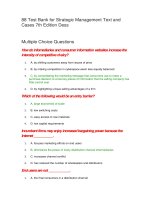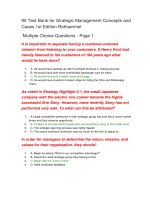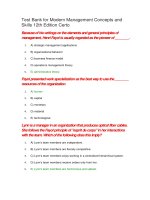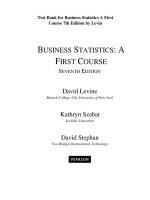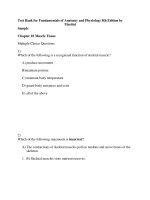Test bank for professional nursing concepts and challenges 7th edition by black download
Bạn đang xem bản rút gọn của tài liệu. Xem và tải ngay bản đầy đủ của tài liệu tại đây (501.84 KB, 9 trang )
Test bank for Professional Nursing Concepts and Challenges
7th Edition by Black
Chapter 5: Ethics: Basic Concepts for Nursing
Practice Test Bank
MULTIPLE CHOICE
1. Which of the following situations is an example of moral distress?
a. You hear nurses in the lounge making off-color jokes about a patient. You
are afraid to speak up for fear of retaliation.
b. You have been late for work a couple of times in the last 2 weeks, and
your co-workers are covering for you.
c. You become romantically involved with a co-worker, which is against the
unit policy, so you resign your position.
d. You purposefully use vague language when explaining a patient's condition to the
family. Staff expects that the patient may be brain-dead, but test results are not
yet conclusive.
ANS: A
A
B
C
D
Feedback
The definition of "moral distress" is distress that results from participating in a
perceived moral wrongdoing due to situational constraints despite attempting
to make a moral choice.
There is no breach of ethics in being late and having co-workers cover for you.
The person acts appropriately to the moral issue by resigning the position.
The person is acting appropriately under current circumstances.
DIF: Cognitive Level: Analysis
REF: p. 91
2. According to Kohlberg's theory of moral development, adolescents who shoplift are
operating in which level of moral development?
Preconventional
Conventional
Postconventional
Developmental
a.
b.
c.
d.
ANS: A
A
B
C
D
Feedback
In Kohlberg's preconventional level of moral development, the individual
is inattentive to the norms of society and is self-centered.
In the conventional level, moral decisions conform to the norms of society.
In the postconventional level, the individual has a highly developed moral
value system independent of group norms.
"Developmental" is not a level of moral development identified by Kohlberg.
DIF: Cognitive Level: Comprehension
REF: p. 93
3. According to Kohlberg's theory of moral development, individuals who act "because it is the
rule of society" are operating in which level of moral development?
Preconventional
Conventional
Postconventional
Developmental
a.
b.
c.
d.
ANS: B
A
B
C
D
Feedback
In Kohlberg's preconventional level of moral development, the individual
is inattentive to the norms of society and is self-centered.
In the conventional level, moral decisions conform to the norms of society.
In the postconventional level, the individual has a highly developed moral
value system independent of group norms.
"Developmental" is not a level of moral development identified by Kohlberg.
DIF: Cognitive Level: Comprehension
REF: p. 93
4. Flight 93, hijacked on September 11, 2001, crashed into the Pennsylvania countryside
because some of the passengers decided to try to take control of the plane and prevent it from
being used as a weapon of mass destruction against structures in Washington, D.C. They
decided to act despite grave danger to themselves. This is an example of which level of
Kohlberg's theory of moral development?
a. Preconventional
b. Conventional
c. Postconventional
d. Conventional phase 4
ANS: C
A
B
C
D
Feedback
In the preconventional level, the person's self-interest takes precedence
over group norms.
In the conventional level, the person conforms to group norms.
People in the postconventional level of moral development may ignore
self-interest and group norms when making decisions and may
sacrifice themselves for the group.
Phase 4 of the conventional level follows group and cultural norms.
DIF: Cognitive Level: Analysis
REF: p. 93
5. According to Kohlberg's theory, which of the following is true of moral development?
a. Participating in decision making promotes moral reasoning.
b. Intellectual development has no effect on moral development.
c. Participating in debates on ethical issues decreases moral development.
d. Holding people responsible for their actions does not improve moral development.
ANS: A
A
B
C
D
Feedback
Kohlberg thought that certain conditions promote moral development, such
as participating in decision making.
Kohlberg thought that intellectual development was necessary for
advanced moral development.
Participating in debates on ethical issues does enhance moral development.
Taking responsibility for actions promotes moral development.
DIF: Cognitive Level: Comprehension
REF: p. 93
6. Gilligan's theory on moral development differed from Kohlberg's theory because
Gilligan considered which population not addressed by Kohlberg?
a. Children
b. Men
c. Women
d. Adolescents
ANS: C
A
B
C
D
Feedback
Kohlberg mostly tested his theory in men and boys.
Men were the focus of Kohlberg's theory.
Gilligan thought that Kohlberg's theory did not recognize the experience
of women in moral development.
Gilligan's theory did not focus on adolescents.
DIF: Cognitive Level: Knowledge
REF: p. 93
7. Which of the following ethical theories is illustrated by the example of following the
Golden Rule, "Do unto others as you wish them to do unto you"?
a. Deontology
b. Principalism
c. Utilitarianism
d. Virtue ethics
ANS: A
A
B
C
D
Feedback
Deontology states that an act is moral if it originates from good will.
Principalism is the use of ethical principles in decision making.
Decisions are made based on what will do the greatest good for the greatest
number of people. A main tenet of utilitarian ethics is that right or useful
actions bring about the greatest good for the greatest number of people.
Virtue ethics refers to character traits of the decision maker, such as
honesty, courage, kindness, and integrity.
DIF: Cognitive Level: Application
REF: p. 95
8. Which of the following ethical theories is illustrated by the example of triage in
disaster nursing?
a.
b.
c.
d.
Deontology
Principalism
Utilitarianism
Virtue ethics
ANS: C
A
B
C
D
Feedback
Deontology states that an act is moral if it originates from good will.
Principalism is the use of ethical principles in decision making.
Triage in disasters requires decisions to be made on how to do the greatest good for
the greatest number of people. A main tenet of utilitarian ethics is that right or
useful actions bring about the greatest good for the greatest number of people.
Virtue ethics refers to character traits of the decision maker, such as
honesty, courage, kindness, and integrity.
DIF: Cognitive Level: Application
REF: p. 95
9. Respecting the right of a patient with terminal cancer to refuse chemotherapy is based on
a belief in the ethical principle of
justice.
autonomy.
nonmaleficence.
death with dignity.
a.
b.
c.
d.
ANS: B
A
B
C
D
Feedback
"Justice" refers to the equality of the allocation of services.
Autonomy is based on the principle that patients have the right to determine
their own course of action.
"Nonmaleficence" refers to the responsibility to do no harm.
Death with dignity is not an ethical principle.
DIF: Cognitive Level: Application
REF: p. 97
10. Respecting an elderly woman's decision to stay in her own home is based on a belief in
the ethical principle of
justice.
autonomy.
nonmaleficence.
death with dignity.
a.
b.
c.
d.
ANS: B
A
B
C
D
Feedback
"Justice" refers to the equality of the allocation of services.
Autonomy is based on the principle that patients have the right to determine
their own course of action.
"Nonmaleficence" refers to the responsibility to do no harm.
Death with dignity is not an ethical principle.
DIF: Cognitive Level: Application
REF: p. 97
11. A school nurse teaching school-aged children about water safety is an example of
which ethical principle?
a. Beneficence
b. Justice
c. Veracity
d. Autonomy
ANS: A
A
B
C
D
Feedback
Beneficence can be seen as "the doing of good."
"Justice" refers to the equal treatment of all.
Veracity is truth telling.
"Autonomy" refers to an individual's right to make his or her own decisions.
DIF: Cognitive Level: Application
REF: p. 97
12. A nurse who advocates for a longer stay when a medically indigent patient is being
prematurely discharged to reduce hospital cost is relying on which ethical principle?
a. Justice
b. Beneficence
c. Autonomy
d. Fidelity
ANS: A
A
B
C
D
Feedback
"Justice" refers to the equal and fair allocation of services based on need.
According to this principle, the patient should receive the same care as others
in the same condition, regardless of ability to pay.
"Beneficence" simply refers to doing good.
Autonomy asserts that individuals have the right to make their own decisions.
"Fidelity" is an incomplete answer, because fidelity refers to faithfulness
or honoring one's promises to patients.
DIF: Cognitive Level: Application
REF: p. 98
13. The current emphasis on eliminating racially based health disparities is based on which of
the following ethical principles?
Double effect
Fidelity
Justice
Veracity
a.
b.
c.
d.
ANS: C
A
Feedback
Double effect is the concept that justifies inflicting harm if the intent is to
B
C
D
produce an overall good effect.
"Fidelity" refers to honoring one's promises to patients.
The principle of justice states that equals should be treated the same.
Veracity is telling the truth.
DIF: Cognitive Level: Application
REF: p. 98
14. A nurse is turning a bedfast patient to prevent pressure ulcers. The patient complains that
the process is painful. The nurse explains the reason for the turning schedule and completes
the task. This is an example of the ethical principle of
a. autonomy.
b. fidelity.
c. nonmaleficence.
d. veracity.
ANS: C
A
B
C
D
Feedback
Autonomy has to do with individuals being able to make their own decisions.
"Fidelity" refers to honoring one's commitments and promises.
"Nonmaleficence" is defined as the duty to do no harm. Although temporarily
painful, not turning the patient would cause actual harm (physical damage),
and so this nurse is acting on the principle of nonmaleficence.
"Veracity" refers to being truthful.
DIF: Cognitive Level: Application
REF: pp. 97-98
15. A patient who is terminally ill is experiencing great pain. To relieve the patient's suffering,
the nurse needs to administer larger doses of morphine. This relieves the pain but also inhibits
respiration. Which principle justifies the risk of harm?
a. Justice
b. Fidelity
c. Veracity
d. Double effect
ANS: D
A
B
C
D
Feedback
Justice relates to equal treatment of all.
Fidelity is faithfulness to one's commitments.
Veracity is being truthful.
The principle of double effect addresses actions that may result in a negative
effect if the end result is good. The end point justifies the risk of harm.
DIF: Cognitive Level: Application
REF: pp. 97-98
16. Taking a pediatric patient to the playroom on a promised time and day is based on the
belief in the ethical principle of
a. autonomy.
b. fidelity.
c. justice.
d. veracity.
ANS: B
A
B
C
D
Feedback
Autonomy relates to the right of individuals to make their own decisions.
Fidelity is being faithful to commitments made to others.
"Justice" refers to the equal treatment of all.
Veracity is being truthful.
DIF: Cognitive Level: Application
REF: p. 99
17. When nurses receive a patient assignment and accept reports on these patients, they are
committed to providing care to those assigned to them. This is based on the ethical
principle of
a. beneficence.
b. fidelity.
c. justice.
d. veracity.
ANS: B
A
B
C
D
Feedback
Beneficence speaks to doing good.
Fidelity is being faithful or keeping commitments made to others. In accepting
the assignment, the nurse has committed to caring for the patients assigned to
her or him.
Justice is related to the equal treatment of all.
"Veracity" refers to one's truthfulness.
DIF: Cognitive Level: Application
REF: pp. 98-99
18. Answering a terminally ill child's questions about his or her condition honestly is based on
a belief in the ethical principle of
a. autonomy.
b. fidelity.
c. justice.
d. veracity.
ANS: D
A
B
C
D
Feedback
Autonomy relates to the right of an individual to make his or her own decisions.
"Fidelity" refers to being faithful to one's commitments.
"Justice" refers to the equal treatment of all.
"Veracity" is defined as telling the truth. Truthfulness is fundamental in
the development and maintenance of trust in a relationship.
DIF: Cognitive Level: Application
REF: p. 99
19. A father of four is admitted after an automobile accident in which two of the children were
killed. Recognizing that he is in very serious condition, the nurse believes that it would be
appropriate to avoid telling him about the death of his children unless he asks directly.
This could be considered a violation of the ethical principle of
a. beneficence.
b. fidelity.
c. justice.
d. veracity.
ANS: D
A
B
C
D
Feedback
Beneficence is the expectation of doing good.
"Fidelity" refers to keeping commitments and promises.
Justice is the treatment of all equally.
Veracity is truth telling. The nurse is not lying but is not forthcoming with
the information about the children.
DIF: Cognitive Level: Application
REF: p. 99
20. Which of the following is the best description of a code of ethics?
a. A document that describes the correct course of action and does not
change regardless of societal changes
b. A document that all professions must have even if not representative of practice
c. A document that permits others to know what principles guide
professional decision making
d. A document widely open to interpretation by professionals in various settings
ANS: C
A
B
C
D
Feedback
Codes of ethics have been revised through the years to reflect changes in society.
Codes are useful only if upheld by members of the profession in their
daily practice.
The Code of Ethics of nursing is an implied contract through which the
profession informs society of the principles and rules by which it functions.
The Code of Ethics should be interpreted in a similar way regardless of
practice setting.
DIF: Cognitive Level: Comprehension
REF: p. 100
21. A nurse is involved in an ethically challenging case. To use an ethical decision-making model,
which step should the nurse perform first?
Gather and examine all possible solutions.
Identify the ethical dilemma in the case.
Identify all parties who will be impacted by the decision.
Gather all information important to the situation
a.
b.
c.
d.
ANS: B
Feedback
A
B
C
D
The first step in many ethical decision-making models is to identify the
ethical dilemma. Examining all possible solutions comes after this step and
gathering information.
The first step in many ethical decision-making models is to identify the
ethical dilemma.
The first step in many ethical decision-making models is to identify the
ethical dilemma. Identifying parties affected is not a specific step but is part
of identifying the dilemma.
The first step in many ethical decision-making models is to identify the ethical
dilemma. The next step would be to gather all data related to the situation.
DIF: Cognitive Level: Comprehension
REF: p. 102
MULTIPLE RESPONSE
1. Which of the following are activities in the ethical decision making process? (Select all
that apply.)
a. Avoid looking at legal cases or precedents related to the situation.
b. Determine if the people who are affected by the dilemma have value conflicts.
c. Brainstorm with others involved to identify all possible solutions.
d. Evaluate the action taken to determine whether it accomplished its purpose.
e. Discuss only acceptable solutions that are practical to implement.
ANS: B, C, D
Feedback
Correct
Incorrect
Determining who is affected by the dilemma and identifying possible
value conflicts among them, identifying all possible solutions, and
evaluating the action taken to determine whether it accomplished its
purpose clarify the situation and determine whether the selected action
achieved its goal.
A variety of materials including legal documents may help clarify the
situation or help identify possible actions. Ethical decision making is not
done in isolation. It may involve others but especially must involve the
patient and family. All possible solutions should be considered even if
they are unusual, complex, or may be difficult to implement.
DIF: Cognitive Level: Comprehension
REF: p. 102

